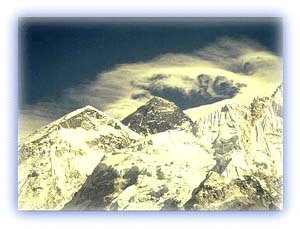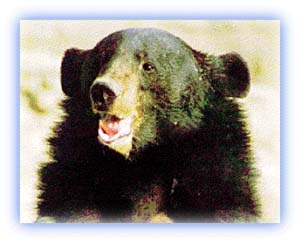Flora and fauna
General Info
· Flora
· Tropical Forests
· Temperate Forests
· Sub-alpine forests
· Alpine scrubs
· Fauna
· Mammals
· Birds
Why are these animals endangered?
How much money do the poachers make?
Protected Areas
· Nepal
· Royal Chitwan National Park
· Royal Bardiya National Park
· Langtang National Park
· Rara National Park
· Makalu-Barun National Park and Conservation Area
· Shey Phoksundo National Park
· Khaptad National Park
· Koshi Tapu Wildlife Reserve
· Parsa Wildlife Reserve
· Royal Sukla Phant Wildlife Reserve
· Dhorpatan Hunting Reserve
· Annapurna Area Conservation Project
· India
· Corbett National Park
· Nanda Devi Sanctuary
· Nanda Devi
· Inner Sanctuary
· Outer Sanctuary
· Present day Scenario
· Kangchendzonga National Park
· Valley of Flowers
· Hemis National Park
· Pin Valley National Park

![]()
|
Sagarmatha (Mt. Everest) National Park This is the highest national park in the world, with the entire park located above 3,000 m ( 9,700 ft). This park includes three peaks higher than 8,000 m, including Mt Everest. Therefore, most of the park area is very rugged and steep, with its terrain cut by deep rivers and glaciers. Unlike other parks in the plain areas, this park can be divided into four climate zones because of the rising altitude. The climatic zones include a forested lower zone, a zone of alpine scrub, the upper alpine zone which includes upper limit of vegetation growth, and the Arctic zone where no plants can grow. The types of plants and animals that are found in the park depend on the altitude. |
 |
| Plume of clouds at the top of Everest Credit: Stan Armington |
In the lower forested zone, birch, juniper, blue pines, firs, bamboo and rhododendron grow. Above this zone all vegetation are found to be dwarf or shrubs. As the altitude increases, plant life is restricted to lichens and mosses. Plants cease to grow at about 5,750 m (18,690 ft), because this is the permanent snow line in the Himalayas.
The Sagarmatha National Park is one of the most beautiful places on earth, especially in summer. After the first monsoon rains in June, different kinds of plant grow rapidly. The hillsides become green and different varieties of flowers start blooming, and butterflies of myriad species appear in different colors.
Due to the presence of insects in the environment, many kinds of birds are also seen in the park. 118 species of birds and 26 species of butterflies have made this park their home.
 |
| Himalayan Black Bear Credit: Mahabir Pun |
Some of the endangered animals that are found in this park are musk deer, wild yak, red panda, snow leopard and Himalayan black bear. Besides, many other animals such as Himalayan thars, deer, langur monkeys, hares, mountain foxes, martens, and Himalayan wolves are found in the park. However, their numbers are not very large and many visitors may not be able to see them.
The oxygen gets thinner with the altitude. Therefore, the animals that are found here are adapted to living on less oxygen as well as a cold temperature. They have thick coats to retain body heat. Some of them have shortened limbs to prevent loss of body heat. The Himalayan bears go into hibernation in caves during the winter when there is no food available.
All rights reserved